Drive-through & Drive-in Racking Systems
The right racking system has a substantial impact on the efficiency and safety of your warehouse operation. As such, it's crucial that you choose wisely.
No one solution is ideal in every context, but a common type of high-density pallet storage system divides into two main categories: drive-in racking and drive-through racking. These strategies serve the same basic function, with both relying on systems of rail beams for dense storage and uprights for vertical support.
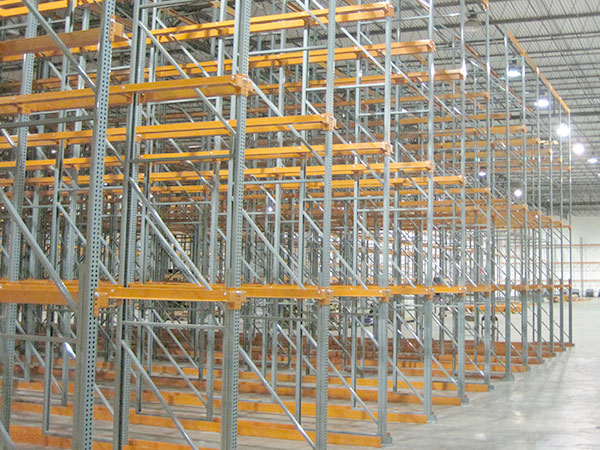
How Can We Help?
The result? Floor-to-ceiling storage that can accommodate a far higher volume of products than other solutions. Both drive-in and drive-through are ideal for large inventories with similar SKUs. Both typically boost durability with help from structural steel, which can significantly increase weight capacities while reducing susceptibility to forklift damage.
While these two systems can look virtually identical to the uninitiated, these solutions actually differ dramatically. The main distinctions involve how, exactly, the pallets are placed and picked.
Drive-in solutions offer cost-effective, high-density storage, in which pallets are simply loaded onto rails situated horizontally. Pallet entry and removal occur in the same location. With a drive-through pallet rack, however, the forklift must load pallets on one side of the rack before eventually unloading them on the other.
The structural differences between the two solutions means that they are preferred for distinct situations. It's important to understand which types of products and warehouse setups are most conducive to drive-in or drive-through rack structure, then develop the proper systems accordingly. To help, we'll highlight several key differences between the two main types below.
Drive-In Pallet Racking
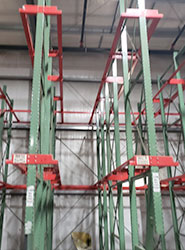 As mentioned previously, a drive-in racking system relies on a single point of entry and exit for pallets as they are loaded and unloaded. The name derives from the need for vehicles to only enter on one side. Under this approach, the same SKUs are kept in the same bay.
As mentioned previously, a drive-in racking system relies on a single point of entry and exit for pallets as they are loaded and unloaded. The name derives from the need for vehicles to only enter on one side. Under this approach, the same SKUs are kept in the same bay.
The drive-in pallet racking system is preferred for last-in, first-out (LIFO) operations, in which the most recently stocked items are also the first to be removed. These solutions provide the greatest storage capacity, thereby maximizing limited warehouse space.
These systems do hold a few downsides, however. The biggest concern is the potential for delays before older inventory is shipped. As such, LIFO is not preferred when expedited shipping is required.
In general, drive-in should be the go-to solution when density is prioritized above selectivity. Yes, there are modest downsides regarding the ability to retrieve items swiftly, but these can easily be offset by the sheer storage capabilities associated with the LIFO solution.
Integration opportunities should also be considered, as drive-in solutions are often paired with push-back pallet racks. Other customization examples include twinlode, dual, or double-wide pallet racking. In select situations, it may be possible to procure customized mezzanines for catwalks, stair towers, or other specialized solutions.
No matter the scope of integration, security and durability are critical, as drive-in systems may otherwise be prone to damage due to increased exposure to forklifts over time.
Drive-Through Pallet Racking
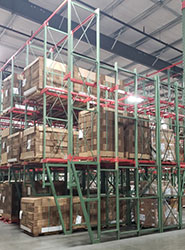 Drive-through racks resemble their drive-in counterparts in several respects but differ in regards to where, exactly, pallets are placed and retrieved. Under this approach, loading always takes place on one side, with unloading delegated to the opposite side.
Drive-through racks resemble their drive-in counterparts in several respects but differ in regards to where, exactly, pallets are placed and retrieved. Under this approach, loading always takes place on one side, with unloading delegated to the opposite side.
The drive-through approach enables first-in, first-out (FIFO) storage. Under a FIFO system, products that arrive at the warehouse early on are typically the first to leave. As such, FIFO can easily accommodate many products that aren’t ideal for LIFO storage.
While FIFO is ideal for a greater variety of products, it's often more difficult to implement. It also may be less adaptable than its LIFO counterparts. Its greater selectivity, however, may make it a preferred setup for applications that require higher turnover — especially if modest compromises in terms of storage density are deemed acceptable.
Advantages of These Systems
Drive-in and drive-through pallet racking systems provide a myriad of benefits for many types of industries and facilities. In general, these systems are preferred for high-density operations involving shelf-stable items. This is particularly true of drive-in solutions, which make the most of limited space but tend to be limited in terms of selectivity.
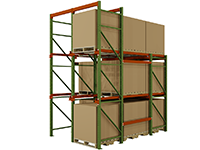
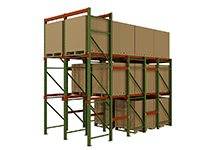
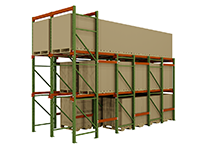
Key opportunities associated with these systems include:
- eCommerce. As compared to other pallet racking systems, drive-in and drive-through solutions provide seemingly endless storage space. Drive-in systems deliver an extra level of cost control, as they can store a higher volume of items within a smaller amount of space, thereby limiting operational expenses. Retrieval processes must be taken into account when choosing a system, however, as selectivity remains a weakness. This may lead to increased shipping times and decreased customer satisfaction.
- Agriculture. Drive-in pallets are often used for consumables, so this solution can be advantageous for certain types of agricultural products. Potatoes, beans, or even seeds are well-suited to this approach, as they can be stored in large quantities for long periods.
- Cold storage. Another often unexpected use of drive-in pallets? Cold or frozen foods. With frozen items, selectivity is typically not as important as density. Drive-in systems are preferable simply because the cost of maintaining freezer space is so high. Given these often exorbitant expenses, it should come as no surprise that enterprises want to make the most of available space. Drive-in LIFO layouts make it possible to accomplish exactly that.
- Beverage storage. Shelf-stable beverages can be stored efficiently and at minimal cost with help from high-density drive-in racking systems. Many companies opt for double-wide drive-in racks for beverage storage, as these easily accommodate transit via refrigerated semi-truck trailers.
- Batch production. When limited SKU counts are required, large batches of products can be stored at reduced cost via a drive-in setup. This is a great option for date-segregated production, particularly when product variation is limited.
When selecting a high-density pallet racking system, think carefully about previously mentioned storage solution downsides, such as limited selectivity and the greater susceptibility to forklift damage.
These concerns can be addressed through proper construction and customized solutions. In many cases, such mitigation strategies will ensure that the benefits of drive-in systems are realized without making unacceptable compromises.
Warehouse1’s Custom Solutions
Whether you prefer drive-in or drive-through pallet racking, you can benefit from the customized warehouse storage solutions that we provide at Warehouse1. We're pleased to offer a variety of high-volume warehouse accommodations that make efficient use of limited space. We know how to make the most of every square foot available.
Ready to optimize your warehouse environment? The experts at Warehouse1 can work with you to develop a strategic system that takes the unique needs of your enterprise into account. When you work with our team, we’ll listen closely to your concerns before helping you craft a solution that is perfectly tailored according to the realities of your industry, your warehouse layout, and your budget. We can also help you prepare for potential pitfalls associated with drive-in and drive-through solutions.
If you'd like to learn more about our customized approach, don't hesitate to get in touch. We'd love to chat about your facilities and your long-term objectives. Contact us today to take the next step towards developing an optimized facility that draws on the power of today's top pallet racking solutions.